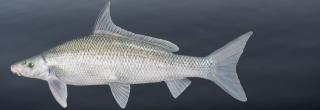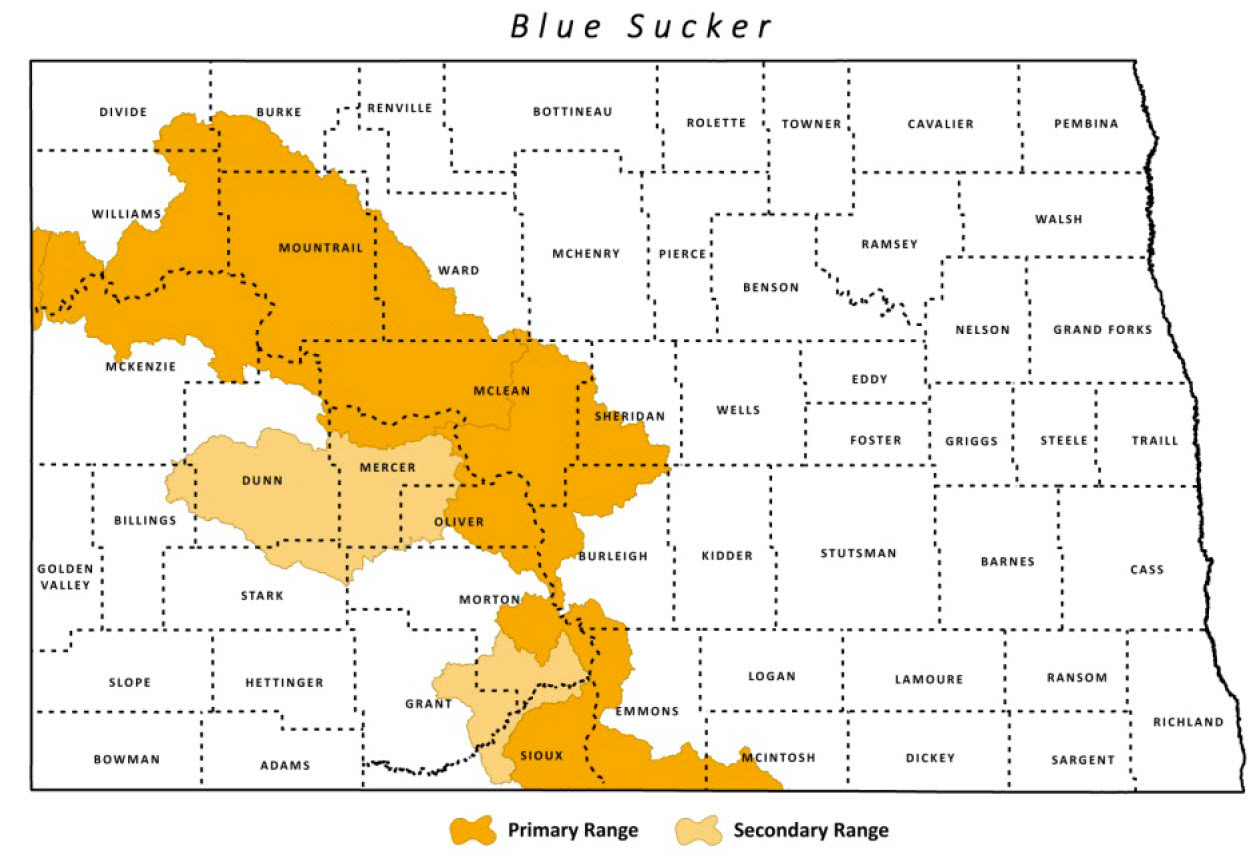
Blue Sucker
| Scientific Name | Cycleptus elongatus |
|---|---|
| General Description | Body generally compressed and elongated. Head small for body size. Bluish gray in color. Dorsal fin long, falcated. Deeply forked caudal fin. Snout rounded with subterminal mouth. Papillae on lips. |
| Status | Year-round resident. |
| Abundance | Rare. |
| Primary Habitat | Deep areas with swift current on medium to large turbid rivers. Bottom normally sand or gravel. Use confluence areas of larger tributaries for spawning. |
| Federal Status | None presently. Former candidate species. |
| Reason for Designation | Loss of freeflowing stretches of the Missouri River due to impoundment and channelization has reduced suitable habitat for this species. |
Locations and Conditions of Key Habitat
Preferred Habitat
This species is well adapted to living in swift current of large turbid rivers. Found mostly in riffles or narrow chutes. Requires gravel bottoms free of sediment.
Key Areas and Conditions for Blue Sucker in North Dakota
Blue Suckers occur at highest frequency in the Missouri River’s freeflowing stretches above Lake Sakakawea and Lake Oahe. The confluence areas of larger tributaries such as the Knife and Cannonball rivers are likely key areas for spawning.
Problems Which May Affect this Species
Habitat
The loss of suitable habitat caused by a change in the riverine regime is the largest problem affecting this species. Historically, Blue Suckers were present throughout the entire Missouri River System. The construction of dams and channelization has largely changed the river system. Dams have reduced the sediment load, which in turn has lowered turbidity. The release of cold water from impoundments has lowered the overall temperature of the system making much of the Missouri River too cold for Blue Sucker. Dams also have fragmented populations by restricting movement throughout the system.
Other Natural or Manmade Factors
The use of water for agricultural, industrial, and municipal purposes along the river may impact Blue Sucker populations by reducing water levels. Entrainment of fish in irrigation systems, and oil and gas development within the basin are also recognized as threats.
Research and Survey Efforts
Current Research or Surveys
- The USFWS, USGS, and Montana Fish, Wildlife, and Parks currently track movements of tagged Blue Sucker in the Yellowstone and Missouri rivers.
Previous Research or Surveys
- A status report for the Blue Sucker was conducted in 1993.
Additional Research or Surveys Needed
- Locate and protect key spawning areas along the Missouri River System.
Management Recommendations
- Protect rivers, streams, and riparian areas where possible (i.e. easements and/or acquisition).
- Work with partners to ensure Swampbuster provisions are maintained.
- Continue to use the Section 404 program to ensure affected rivers and riparian areas are mitigated to replace form and function.
- Continue to work with other federal agencies (i.e. FAA and FHWA) not covered by Section 404 or Swampbuster to ensure affected rivers and riparian areas are mitigated to replace form and function.
- Continue to work with NDSWC to develop minimum in-stream flow recommendations.
- Develop and promote incentive programs to restore riparian areas.
- Work with county zoning planning officials to designate areas in need of protective covenants
- Continue to work with ND 319 Task Force in prioritizing projects within impaired watersheds and implementing BMP’s.
- Develop and promote incentive programs for adjacent landowners to improve bank stability through land use changes (e.g. RRBRP).
- Promote non-traditional bank stabilization measures (i.e. root wads, willow waddles, vegetative slope).
- Implement intake conditions or recommendations (i.e. screening and velocity requirements).
- Work with the dam owners for potential removal or modification.
- Control noxious weeds through biological and chemical methods.
- Cooperate with Fisheries Division on state aquatic nuisance species plan.
- Survey areas of data gaps. Conduct research/surveys to establish baseline information on SCP.
- Continue to work with partners in promoting and distributing educational materials related to river, stream and riparian values and good stewardship.
Monitoring Plans
Present surveys will be maintained to monitor this species.
2005-2015 PROGRESS
The Blue Sucker maintains its Level I Species of Conservation Priority ranking. Currently a project to identify this species important spawning areas is under development.

Note: A listing of works consulted when compiling the information on this page may be found in the 2015 State Wildlife Action Plan.
